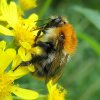Bees struggle to find flowers because of air pollution
A new study has found that air pollution is preventing pollinators finding flowers because it degrades the scent.
A new study has found that air pollution is preventing pollinators finding flowers because it degrades the scent.













